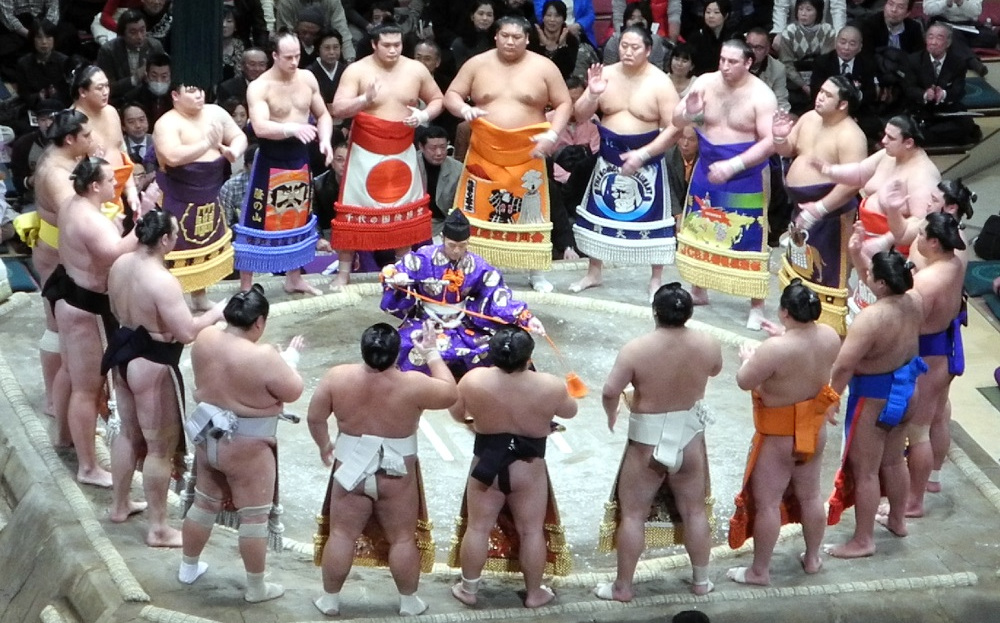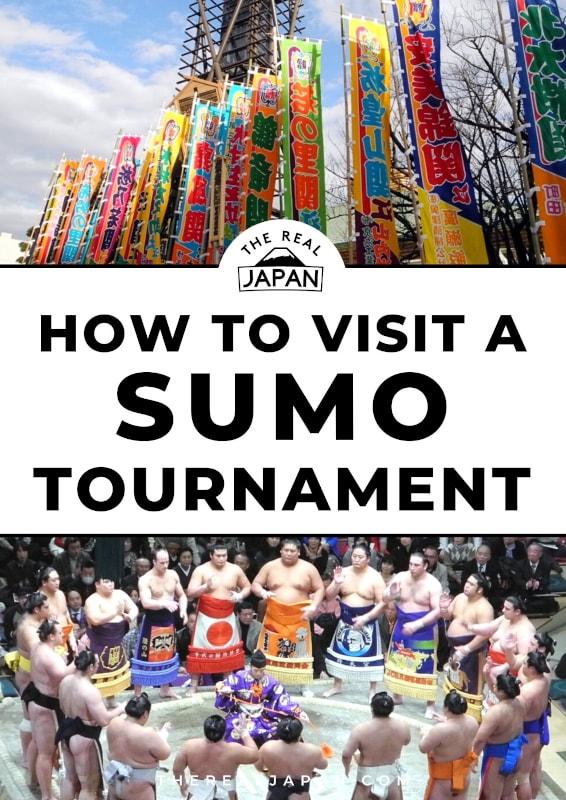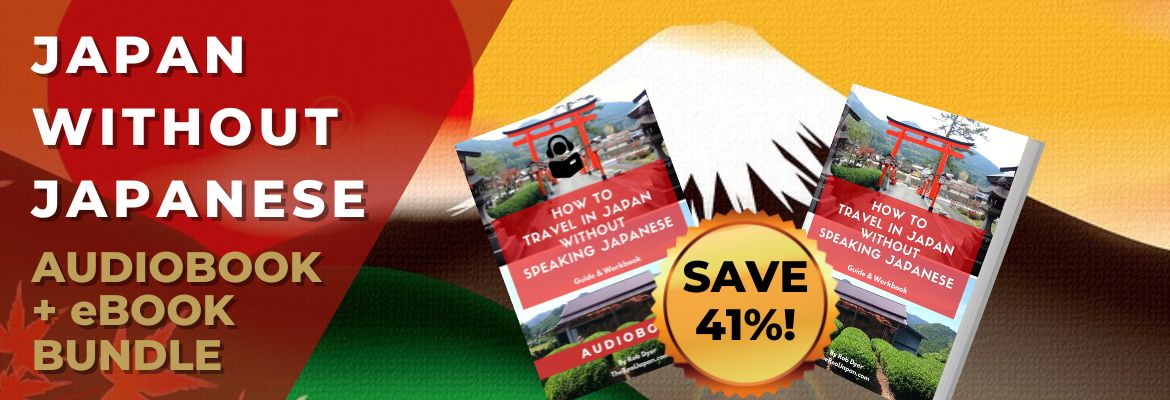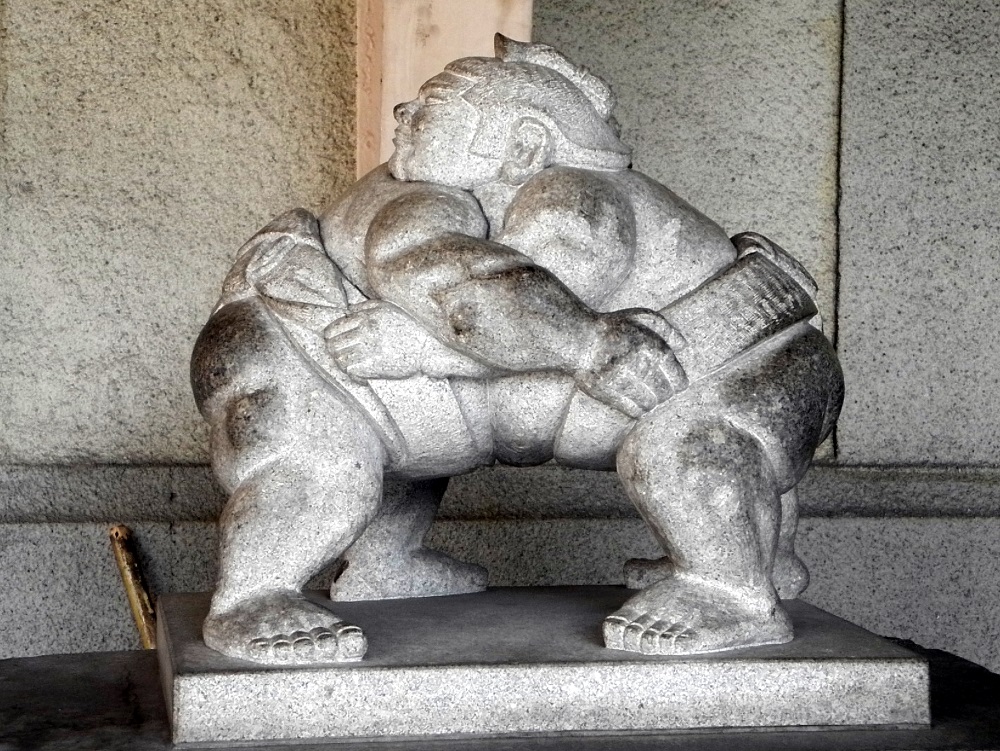Sumo wresting, Japan's most iconic sport, evolved from a religious ritual performed in Shinto shrines more than 1,500 years ago, making it the oldest organised sport in the world.
Six tournaments (known as basho) take place every year in four of Japan's major cities: Tokyo, Osaka, Nagoya and Fukuoka.
Even if you only have a passing interest in sumo, watching the colourful spectacle live with 10,000 fans is an experience not to be missed.
Visiting A Sumo Tournament
by Rob Dyer
Although it has lost its top spot as Japan's most popular national sport (that now goes to baseball), sumo remains the quintessential Japanese sport. Its massive wrestlers are the hallmark of this most ancient of Japanese pastimes.
In the past, high ticket prices and limited availability were also issues.
But with the decline in popularity of the sport in more recent times, triggered in part by corruption and gaijin (foreigners) replacing the native Japanese in the higher ranks, seats are more readily available these days and at prices that are more affordable too.
I was a big fan of sumo many years ago, around the time when Channel 4 broadcast the tournaments in the UK, back in 1990 (which I still have on video tape!) but I'd never quite managed to coordinate a trip so that it coincided with one of the annual tournaments.
But a while back I did.
Six Grand Sumo tournaments every year
There are six Grand Sumo tournaments (or basho) each year. Half of them are at the famous Ryōgoku Kokugikan stadium in Tokyo in January, May, and September, and one each in Osaka (March), Nagoya (July) and Fukuoka (November).
Each tournament begins on a Sunday, runs for 15 days, ending also on a Sunday. This time, I'd arranged to fly to Tokyo in January - deliberately to overlap with the basho that gets the season underway.

Buying tickets
Buy Tickets for the Next Sumo Wrestling Tournament - select your preferred date and choose from three different seating options.
If you have difficulty getting tournament tickets, or you want to try one of several sumo experiences and tours that take place in Japan throughout the year, you should check out my post 7 Best Sumo Experiences You Can Book Instantly.
Watch Grand Sumo highlights online (for free)
Japanese national broadcaster NHK provides detailed coverage of the sumo tournaments throughout the year. Those outside of Japan can watch on-demand highlights of the bouts via it's NHK World channel online. Commentary is in English.
Video highlights of the bouts of every basho are posted daily during tournaments. They also pick out their 'Bout of the Day'. The site provides information on the wrestlers (including 'Wrestlers to Watch'), techniques, and a Q+A section.
Their Sumopedia features interviews with the stars of the sport, champion profiles and sumo training and health exercises.
VIDEO: A Day in the Lives of Sumo Wrestlers
2024 Tournament Schedule
Hatsu basho - Tokyo
Ryōgoku Kokugikan, Tokyo, 14 January – 28 January
Haru basho - Osaka
Edion Arena (Prefectural Gymnasium) Osaka, 10 March – 24 March
Natsu basho - Tokyo
Ryōgoku Kokugikan, Tokyo, 12 May – 26 May
Nagoya basho - Nagoya
Dolphons Arena (Aichi Prefectural Gymnasium) Nagoya, 14 July – 28 July
Aki basho - Tokyo
Ryōgoku Kokugikan, Tokyo, 8 September – 22 September
Kyushu basho - Fukuoka
Fukuoka Kokusai Center, Fukuoka, 10 November – 24 November
Buy Tickets for the next Sumo Tournament - select your preferred date and choose from three different seating options.
Arriving in Tokyo
Friday - The plan was to stop on arrival in Tokyo this time and do some stuff here for a few days before heading down to home in Kobe.
We rented an apartment to use as a base in a quiet part of the city. It was compact and overlooked one of the city's many elevated train lines but it was quiet, impeccably clean, air conditioned and reasonably priced.
Besides, the view over the train tracks enabled me to get some nice shots of passing local trains and shinkansen. 😉
Watch Early Morning Sumo Training in Tokyo at a Sumo Stable
The hotel also provided a luggage forwarding service (this kind of service is fairly commonplace in Japan) meaning we need not lug our large cases with us down to Kobe in a few days time - they would simply be waiting for us at home when we arrived.
We lived out of one small case for the few days we were here. We took a stroll around the local neighbourhood on the first night and opted for dinner in an izakaya - which did a superb pork steak in a delicious sauce.
Planning your day
Saturday – Next morning we met up with a friend of ours who lives in Tokyo, and hung out for the morning not far from Ueno.
My wife and I then headed over to the Ryōgoku Kokugikan stadium for the first basho of the year, and my first ever sumo tournament.
Doors open as early as 8am, with the first bouts beginning at 8:30am (and from 10am after day 13 of the basho).
However, these are the only the preliminary bouts. However, it's typically around 2:40pm that the second division Jūryō bouts begin and things start to get tasty ;-).
Ryōgoku Kokugikan Stadium
We arrived about half an hour later than planned, around 2:30pm, just towards the end of the junior rank bouts.
Walking up outside we were lucky enough to see a couple of the wrestlers strolling in their yukata away from the stadium, possibly off to grab some chanko nabe (hotpot) for lunch! Actually, it is possible to sample some chanko nabe yourself as part of one of a few specialised sumo experiences.
Viator has several that are very highly rated by customers, and their Challenge Sumo Wrestlers and Enjoy Chanko Nabe Lunch and the Tokyo Sumo Morning Practice Tour in Ryogoku with Sumo Lunch experiences both include a chanko nabe lunch as part of the activity.
Take my Sumo Experiences Quiz!
Answer just a few quick questions and I'll give you my recommendation for the best sumo experience for you.
The walk up to the stadium is a riot of multicoloured banners celebrating the wrestlers, and there's a real carnival/festival atmosphere outside the stadium with hundreds of people milling around, grabbing a late bite from one of the street food vendors or local restaurants.
Family groups spanning three generations, young couples dating, a sprinkling of foreign tourists, and press all partaking and adding to the sense of occasion.
Only just avoiding having the obligatory photo taken with Hyochan - the sumo mascot (a black and yellow bird dressed in a sumo belt and with a black top knot hairstyle), we then took to our seats.
You Only Live Twice Mr. Bond!
Geek that I am, I'd waited for this moment for the best part of 40 years after seeing Sean Connery as James Bond take up a cushion to watch sumo in You Only Live Twice - which was filmed in this very arena.
It turned out to be every bit as enthralling as I'd hoped – even without the fear that villainous assassins were trying to bump me off ;-).
Buy tickets for the next Sumo Tournament HERE - select your preferred date and choose from three different seating options.
Aside from the bouts themselves, there's a lot of ceremony to watching sumo.
This tradition and the long history of the sport is recorded in various places around the stadium. The huge banners hanging from the roof - depicting paintings of famous champions add to the atmosphere inside the arena.
Free daily programme
Be sure you pick up the free daily programme and check the timings throughout the day, so that you don't miss the entrance of the top division wrestlers (around 3:45 pm), followed directly by the current Yokuzuna - the highest ranking champion.
Afternoon become early evening as the senior ranking wrestlers stepped into the dohyō (ring) until the bouts for the day ended at 6:30pm with the traditional Japanese bow twirling ceremony. Although our seats were quite high up, the view of the ring was fine.
Using my camera I was able to get some decent photos and video clips too (when the three elderly ladies in the row in front of us weren't leaning forward and shouting out the names of their favourites).
Watch Early Morning Sumo Training in Tokyo at a Sumo Stable
It was good fun but less exciting than if I knew who the wrestlers were these days. (I'm somewhat out of touch.) I would definitely go again, but would like to have followed a season or two before going and have at least one or two wrestlers to cheer (and others to boo!) so as to get the most out of the day.
Even if you only have a passing interest, visiting a sumo tournament is a great way to spend an afternoon/evening.
How to spot sumo stars
Many of the top division (makuuchi) wrestlers arrive at the South Gate around 2pm each day. Its easy (and permitted) to hang around here before they arrive and stake out a good position near the pavement.
Cars drop the wrestlers off and they walk up the path to the entrance to the arena - affording fans the chance to see some of their heroes up really close!
Listening to English commentary
If you want to listen to live, running commentary in English, you can rent radios for just 100 yen inside the stadium. Commentary is provided between 4 and 6pm each day. You'll need to also leave a small deposit - which you collect back when you return the radio.
NHK World's online highlights coverage includes commentary in English.
Ryogoku Kokugikan Stadium
1 Chome-3-28 Yokoami, 墨田区 Sumida-ku, Tōkyō-to 130-0015, Japan
Location Map (Ryogoku Kokugikan Stadium)
If you enjoyed this post please share this image:
Resources
Buy Tickets
Buy tickets for the next sumo tournament
Tickets for the next sumo tournament can be purchased using this link.
Take My Sumo Experiences Quiz
Take the Quiz (No email required)
Watch Grand Sumo Online
Official Japanese Sumo Website
Nihon Sumo Kyokai Official Grand Sumo Home Page
Further Reading
7 Best Sumo Experiences You Can Book Instantly







Hi Rob and TheRealJapan fans. Thanks for adding the Search bar. First thing I did was search for sumo and found this page. Excellent! We were able to see one day of the 2023 Fukuoka tournament and my life was forever changed. The written materials they give you when you enter are great souvenirs. The poster of nine sumos (including, of course, Yokozuna Terunofuji) is now hanging by my rowing machine to give me inspiration. There’s so much to learn and it’s good to have the basics before you go. This is a great overview. Watching NHK’s coverage is a good start, too. So happy our amazing trip to Japan (helped immeasurably by Rob’s tips) lives on six times a year through these tournaments.
Hi Jo – thank you so much for sharing your experiences travelling in Japan and your love of sumo in particular. Which reminds me, I need to go again soon!
Thanks Rob! Glad I found you 🙂 Travelling with my 15yo son in September – in time for the Aki Basho!! Super excited and will start following the wrestlers now. Something I read mentioned age limits for the venue? Any issues with a 15yo at Ryōgoku Kokugikan? Also, is it wise to book all tickets in advance for all bouts we want to see? I will definitely try for the grand final first.
Hi Sheryl, glad you found me!
Children of all ages can watch sumo (including at Ryōgoku Kokugikan) but some require tickets and some don’t depending on their age. Here’s the breakdown:
Children 3 years old or younger can enter for free if they don’t need their own seat.
Children aged 4-15 (inclusive) a child ticket is required.
Children aged 16+ are considered adults.
For age verification, children (under 15 years old) you’ll need bring a document that can confirm their age (student ID card, public certificate with date of birth). Adults (ages 16-59) do not require any age ID.
(Note: these rules apply to the sumo tournament bouts themselves. Any other special events happening around the tournament may have different rules.)
Yes, it’s a very good idea to buy tickets in advance, particularly if you’re looking for the latter stages of a tournament as they are likely to sell out. (A limited number of tickets are available at for purchase at the venue on the day, but the queues for these can start very early, and once the allocation is sold out, that’s it.)
Tickets for the September basho (10th to 24th) go on sale on August 5th. The BuySumoTickets.com website is already accepting pre-orders for the September tournament in Tokyo (10th to 24th).
Hope that helps. Enjoy the sumo!
Good morning, Visiting Japan was a Present to me. We love NHK, it is our “go to” Station! We watch Sumo every time it is on. We love the food, the scenery, the Beauty, and honesty, and the great Respect shown in every way so generously. We appreciate, and so much value your friendship to our Country; Thank you! To be Noble is not one’s Station, it is one’s great Intention to Goodness, Kindness, and Respect: given so graciously to all persons and to our environment. Every person creates … ; I Believe in aknowledeging! RBB
Thanks for sharing your story Rhoda.
NHK is really helpful to those outside of Japan who want to follow the sumo tournaments each year.
Hope you are able to return to Japan before too long.
I had the opportunity to see a Grand Sumo Tournament in Fukuoka in 2017. We had to go to the stadium at 7:30 in the morning to get tickets. They hold out a limited number of seats in the upper corners that are available on a first come first serve basis for that same day. Keep that in mind if you want to see a tournament and you miss out getting tickets before they are “sold out”. It is well worth the extra effort. I think the tickets were 3700 yen each. One of my favorite experiences in Japan. Rob can help you out with several options if you have him plan a trip for you.
Thanks for sharing your experiences Brek. That’s a good reminder about them holding back a limited number of tickets for sale on the day at the stadium. Always worth a try if you haven’t bought tickets in advance and want to try your luck on the day.
Anyone interested in having me help plan their trips to Japan can check out our services here: https://www.therealjapan.com/japan-travel-services
How cool is this Rob? I started following sumo just a little bit when a few sumo-type wrestlers became popular in entertainment-only WWF. Yokozuna comes to mind.
Yokozuna is the higest rank in sumo but I never knew there was a wrestler named that in the WWF. Thanks Ryan for expanding my knowledge!